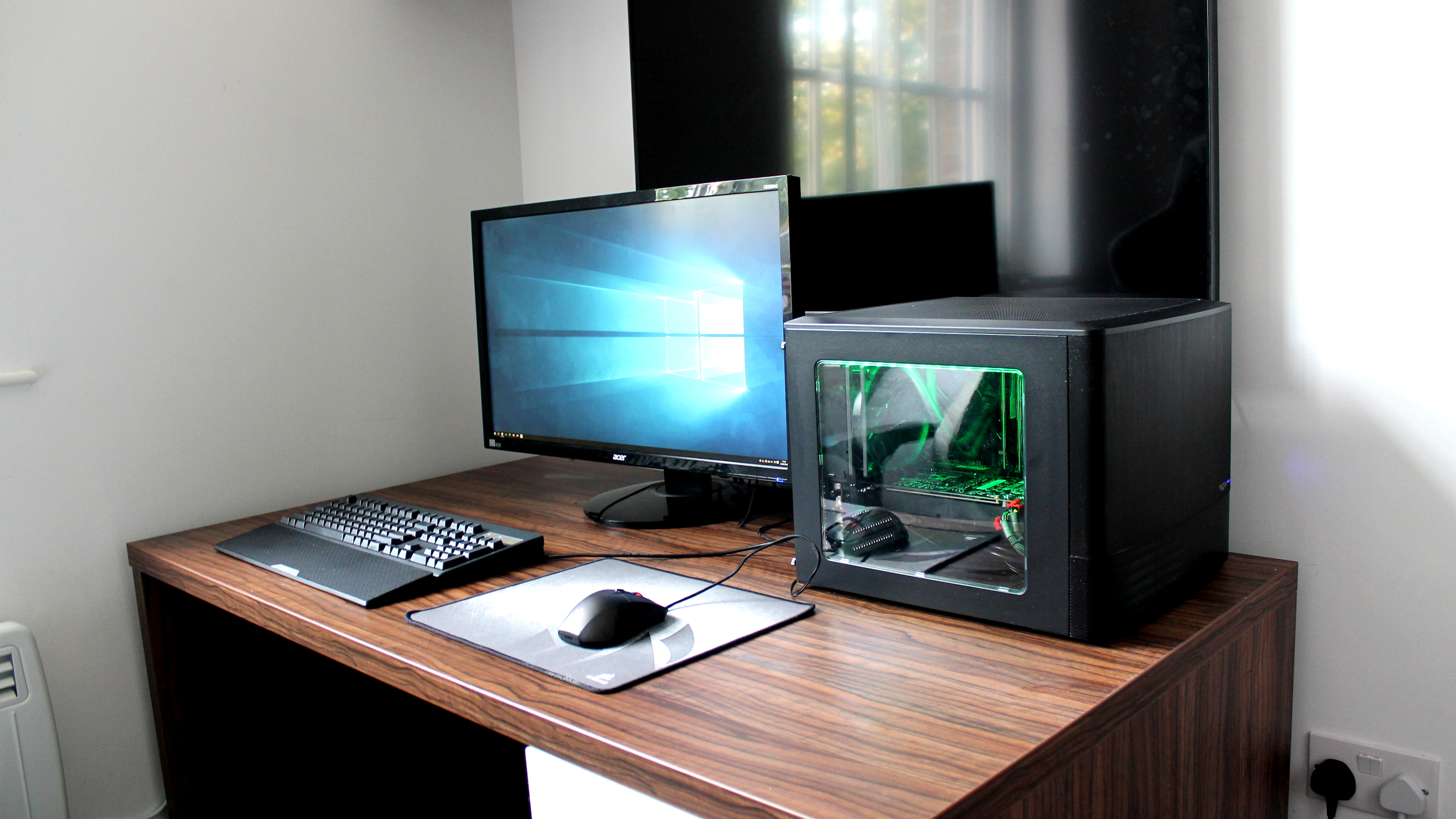TechRadar Verdict
Games look fantastic and run smooth on the Titan Hadron at 1440p, thanks to Nvidia's GTX 1060 inside. Its classy-looking case hides top-tier components, including a nippy SSD and overclockable Intel processor.
Pros
- +
Overclockable processor
- +
Primed for VR and 1440p gaming
- +
Nippy SSD storage
- +
Attractive design
Cons
- -
Can get a stronger GPU for less
- -
Not cut out for 4K gaming
Why you can trust TechRadar
Nvidia hasn't so much shaken up mobile gaming with its desktop-grade Pascal notebook GPUs as turned it completely on its head. The company's GTX 10-series graphics card have also made a mark in the desktop space, providing an opportunity for system builders to come up with powerful, single-GPU configurations capable of running the best VR games and demanding 4K setups.
Called the Titan Hadron, the latest machine from Stoke, UK-based system builders Overclockers UK promises oodles of gaming grunt, courtesy of Nvidia's GTX 1060 GPU. But, as we now know, there's no such thing as a cheap Pascal card.
Even at the mid-range, Nvidia's card pushes up the Hadron's price to £1,091/US$1,4453/AUS$1,894, with an offer currently shaving £30/$US40/AUS$52 from the price.
However, it's important to note that the cost includes a number of enviable features. Among them are an SSD along with a capacious HDD, an overclockable, top-tier Intel processor and, of course, one of the beefiest graphics cards around.
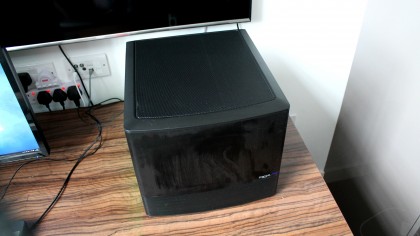
Micro machine
One of the more interesting aspects of the Titan Hadron is its design. Overclockers has gone for Fractal Design's Node 804 Micro-ATX case, which separates warmer running components from cooler ones while allowing for unrestricted airflow to the Asus Z170M motherboard and sixth-generation Intel Core i5-6600K processor inside.
We're a fan of the case's unassuming appearance. Black materials dominate without appearing bland, in part thanks to a brushed aluminum finish on the front panel that contrasts with a plastic mesh along the bottom. Viewed head-on, it looks like a high-end subwoofer that's part of an expensive speaker set-up.
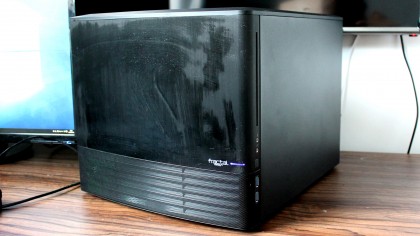
Rotate the Titan Hadron on its side, and the mask slips, revealing a view that's more typical to PC gamers. A transparent side panel provides a view of the various components inside, which are bathed in a green light that emanates from the top of the case's roof.
Spec sheet
Here is the Overclockers UK Titan Hadron configuration sent to TechRadar for review:
- CPU: 3.5GHz Intel Core i5-6600K (Quad core, 6M Cache, up to 3.9GHz using Turbo Boost)
- Graphics: Gainward GeForce GTX 1060 Dual (6GB GDDR5)
- RAM: 8GB DDR4 (2,400MHz)
- Storage: 240GB SSD; 1TB HDD (7,200 rpm)
- Ports: 1 x USB 3.1 (Type-C), 3 x HDMI, 2 X DisplayPort, 2 x DVI-D, 3 x USB 3.0, 2 x USB 2.0, 1 x VGA, headphone/microphone ports, Ethernet
- Size: 12.09 x 13.54 x 15.31 inches (H x W x D)
- Weight: 13.22 pounds (6kg)
Don't be fooled by its name – the Titan Hadron isn't powered by Nvidia's wallet-intimidating Titan X; nor does it fire tiny particles around super quickly, for that matter.
It actually opts for a more sensible choice of card in Gainward's GeForce GTX 1060, which sports 6GB of GDDR5 memory. Compared with Nvidia's newer GTX 1060 that has half the video memory at 3GB, the version on offer here is much more suited to 1440p gaming, much less 1080p.
The Intel's 6600K Skylake processor is more than capable of matching the Nvidia part, the 'K' denoting that it can be overclocked to provide horsepower for gaming. It's more than up to the task out of the box, but overclocking is a welcome option to have for enthusiast users who can get their hands dirty in MSI Afterburner or another tool of choice.
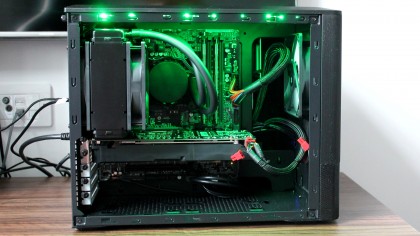
You won't get caught short for ports, as there's an abundance of I/O around the back. That includes a USB 3.1 Type-C port for speedily transferring data to an external hard disk or hooking up a compatible peripheral.
There are two more USB 2.0 ports on the right hand side of the case, located alongside headphone and microphone ports, the power button and slot loading CD drive. These can be fiddly to access if the machine is facing a direction that hides them out of view, forcing you to run your hand along the edge to find them. Relocating them to the top of the case wouldn't have been a bad move.
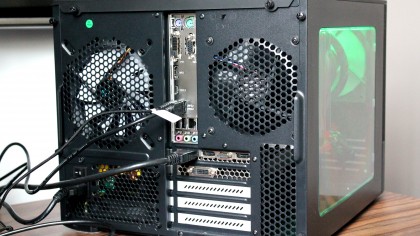
Benchmarks
Here's how the Overclockers UK Titan Hadron performed in our suite of benchmark tests:
- 3DMark: Cloud Gate: 19,409 ; Sky Diver: 23,179 ; Fire Strike: 10,072
- Cinebench CPU: 599 points; Graphics: 126 fps
- GeekBench: 3,980 (single-core); 11,498 (multi-core)
- PCMark 8 (Home Test): 4,568 points
- GTA V (1080p, Ultra): 43 fps; (1080p, Low): 163 fps; (4K, Ultra): 14 fps
- The Division: (1080p, Ultra): 60 fps; (1080p, Low): 150 fps
- Steam VR Bench: Ready
Nvidia says that the GTX 1060 is good for GTX 980-grade frame rates, and our benchmarks show that to be true. The Titan Hadron scored 10,072 in PCMark 8's Fire Strike benchmark, compared to the 9,284 achieved by the 980-powered Asus GX700.
Overclockers' machine also scored higher in Cinebench R15's graphics test (126.3 fps versus the GX700's 101.26 fps), and more than double in our demanding GTA V 1080p Ultra settings benchmark (43.3 fps versus 21 fps).
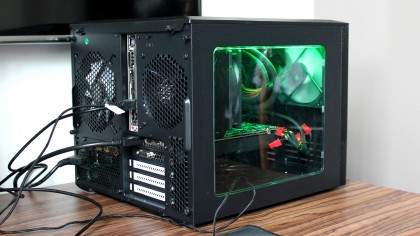
With the exception of extremely demanding games, like GTA V, the GTX 1060 is capable of maxing out games at 1080p; it's also a solid performer at 1440p. We played Doom at that resolution on Ultra settings and got a consistent 55 - 70 fps, depending on which environment we were in. As expected, it struggled at 4K, straining to reach around 30 - 45 fps at 4K on Ultra and frequently dipping to as low as 25 fps.
It almost goes without saying that the GTX 1060 isn't as powerful as the GTX 1070, losing out in every GPU benchmark compared to the StormForce Tornado that we recently reviewed. At £899/US$1,180/AUS$1,540 the Tornado also costs less despite having the more powerful GPU.
On the other hand, it only comes with a weaker (and not overclockable) Core i5-6500 CPU and misses out on an SSD, both of which are major scoring points in favor of the Titan Hadron.
Final verdict
There's a lot to like about the Titan Hadron. We found favor with its minimal, no-nonsense case that provides easy access to components and makes a refreshing change from conventional tower PCs.
Nvidia's GTX 1060 has proven itself to be a great option for 1440p gaming, striking a balance between cost and performance, and the version with 6GB of video memory on offer here leaves you confident you can whack up the graphics options to hit that magic 60 fps mark. Its SSD provides nippy loading of files, and that overclockable CPU provides an avenue for more advanced gamers to eke out even more power.
On the other hand, the machine is simply not up to the task of fluid 4K gaming on Ultra, or even High settings, depending on the title – you're going to need a machine like the StormForce Tornado with a GTX 1070 for that. And, considering the Titan Hadron costs more than a grand, that might be a deal-breaker for some.
